Feature: Knittyspin
INTRODUCTION
Knittyspin
When Is a 2-ply Yarn Not Really a 2-ply Yarn?
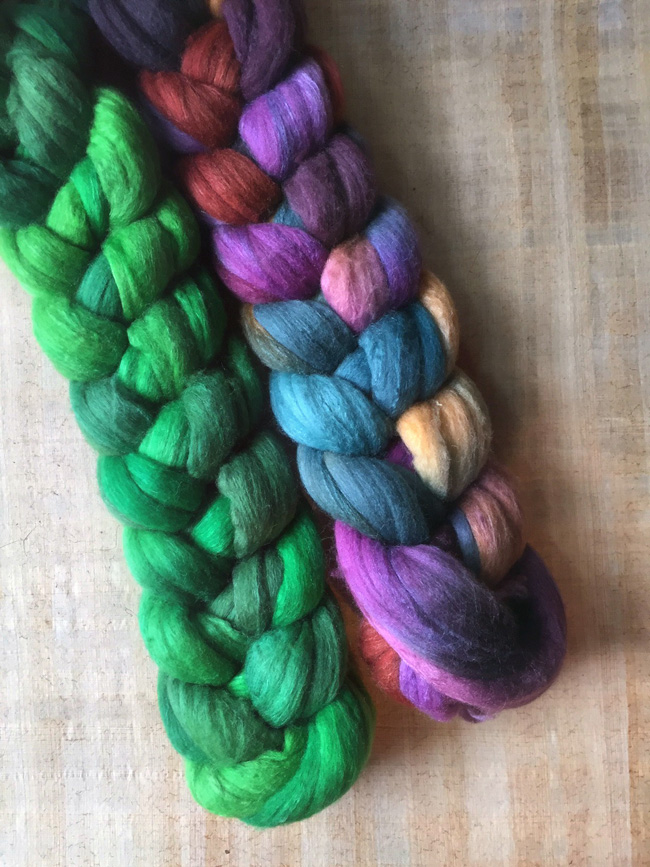
Three Waters Farm Merino/Silk
One of my favorite yarns to spin and knit with is an over-plied 2-ply. For a long time I didn’t think about why, except that I liked how it looked. Now that I’ve been spinning and knitting with handspun longer I have more ideas why I like that extra-plied 2-ply.
I am a cheater, not in deceitful way, but as Merriam Webster puts it, “ to position oneself defensively near a particular area in anticipation of a play in that area". Also, I’m a lazy spinner. If there is an easier, quicker, short cut way of doing things, I am there, smiling. And I have noticed that an over-plied plied 2-ply yarn can technically mimic a 3-ply yarn.
3-ply yarns are mighty. They are strong, round, defy pilling and give great stitch definition. I like a good 3-ply yarn but sometimes I can’t or don’t want to use one. I might not have enough fiber or like how the colors play out or I just don’t want to spin a 3-ply.
What’s a spinner to do? Cheat a little.

Plied to balance, left and plied with over twist, right
Now when I talk about over- or extra-ply I mean slightly over from balanced. This yarn doesn’t bias when knit. Think about many commercial sock yarns – they frequently are over-plied. This yarn has extra ply twist, not crazy ply twist. It has 2 or 3 twists instead of an open loop when finished.
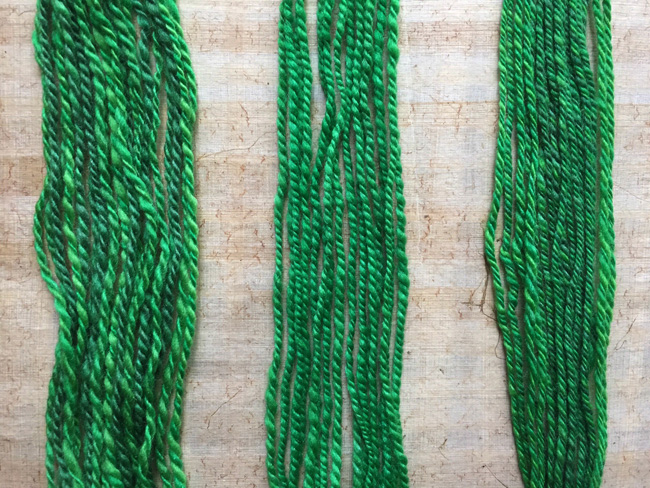
Left to right: 2-ply balanced, 2-ply over-plied, 3-ply balanced
So why or when would I use an extra 2-ply instead of a balanced 3-ply ?
The two completely personal, I-can’t-sample-it-out reasons are: I like how it looks, and I don’t feel like spinning a 3-ply yarn. They are just as valid as any of the reasons I can sample for you.
But there are some delicious reasons that I spun and knit samples to show you. My extra-plied 2-ply affects stitch definition, durability, weight, yardage, and color.
This, my spinners, is why I sample so much. The possibilities are infinite. Wait until you see.
Have I mentioned lately that twist is the most magical element in spinning? You can’t make yarn without it and it transforms a yarn like no other element in a spinner’s toolbox.
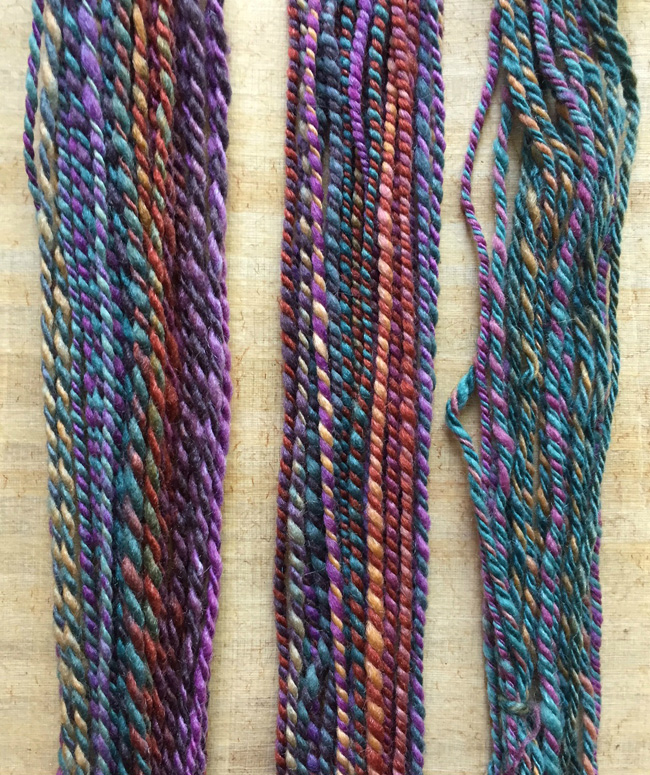
Ply and twist makes a difference in color too.
Here’s what I did for my samples. For all of these samples I used Three Waters Farm Merino/silk top, spun with a woolen draft. For most of the samples, I used the colorway Springing for Green and for the variegated color samples I used the colorway Three Ladies.
For all of the samples, I compared a balanced 3-ply, a balanced 2-ply and an extra-plied 2-ply.
A note on twists per inch vs bumps per inch.
I measured Bumps Per Inch rather than Twists Per Inch on my plied yarns to see how much more twist I put in the over-plied 2-ply. I learned it from Maggie Casey. It’s faster, makes more sense to me and I’m never going back.
Measuring bumps is just that: measuring the twist bumps in a plied yarn in an inch. To get a Twists Per Inch measurement in the same yarn, measure the Bumps Per Inch and divide that number by the number of plies. Why add that extra step?
The Bumps Per Inch of the balanced 2-ply and the over-plied 2-ply measured out this way:
balanced 2-ply – 5 BPI; over-plied 2-ply – 10 BPI. It’s easy to see the over-plied 2-ply has twice as much ply twist as the balanced 2-ply.
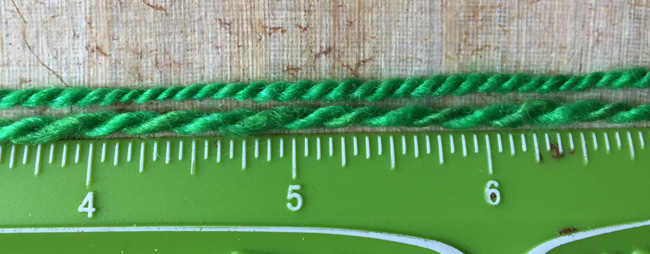
Measuring Bumps Per Inch
Stitch definition
I knit my yarns in stockinette, seed stitch and a 6-stich cable over eight rows.
In all of the samples, the balanced 2-ply looks the most different...it's softer. The seed stitch and cable are visible and readable as stitch patterns, but they are lacking the umph of the other two. On the other hand, these samples in any stitch are wonderfully drapey.
I’ve included a balanced 2-ply swatch in the photos for reference, but I’m focusing on the extra-plied 2-ply and the balanced 3-ply for comparison. Do I even need to tell you I was surprised and delighted when I put my swatches side by side?
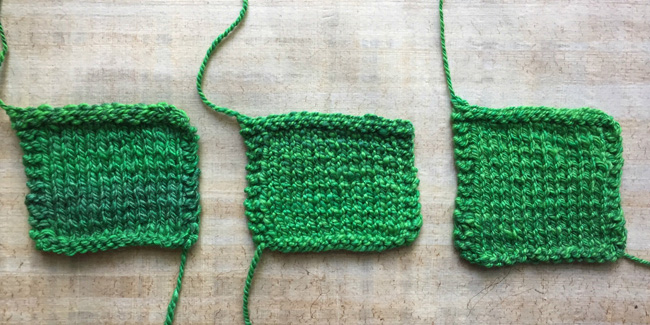
Stockinette stitch left to right: balanced 2-ply, over-plied 2-ply, 3-ply.

Over-plied 2-ply, and 3-ply close-up.
As always, I love that 2-ply and 3-ply swatches are so different looking. The 2-ply looks looser, not just gauge-wise, but the stitches not as lined-up. There’s a little visual surface activity in the sotckinette. The 3-ply lines up straight and the stitches are tidy and crisp.
Get a load of the over-plied 2-ply. I expected it to be more like the 3-ply and it is. The stitches are crisper than the balanced 2-ply, which is what I wanted, but they are so lively! They look fuller and like they want to escape the swatch. I crazy like it.
Seed stitch
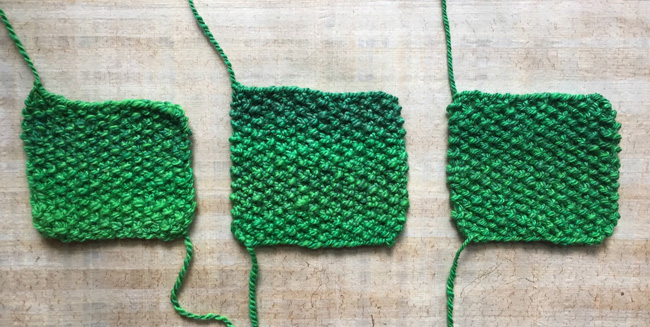
Seed stitch left to right: balanced 2-ply, over-plied 2-ply, 3-ply.
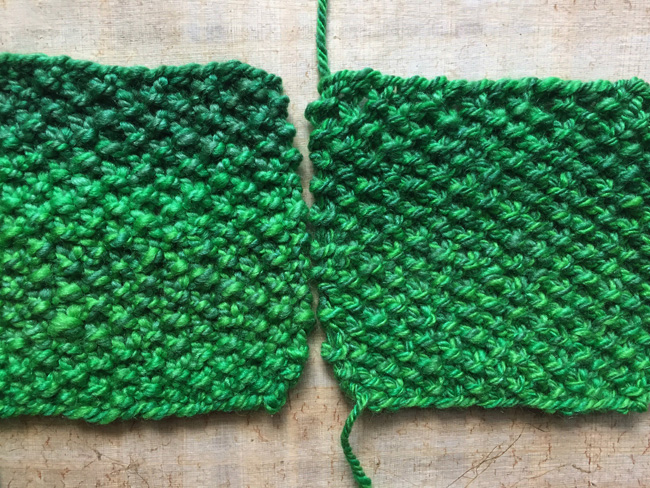
Over-plied 2-ply, and 3-ply close-up.
I see the same phenomenon in the seed stitch between the over-plied 2-ply and the 3-ply. The over-plied 2-ply stitches are plump and full, more defined than the balanced 2-ply, but that extra ply twist makes the seed stitch look downright springy. Boing, boing.
Cable stitch
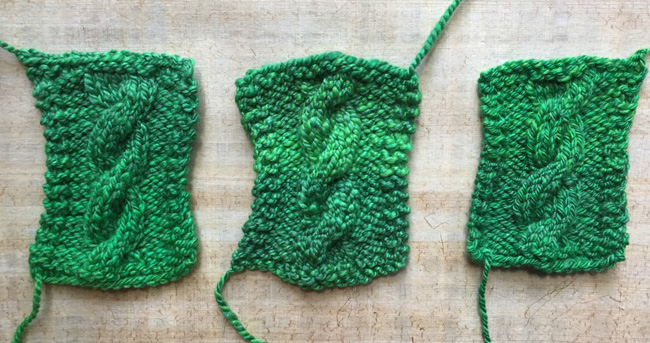
Cable stitch left to right: balanced 2-ply, over-plied 2-ply, 3-ply.
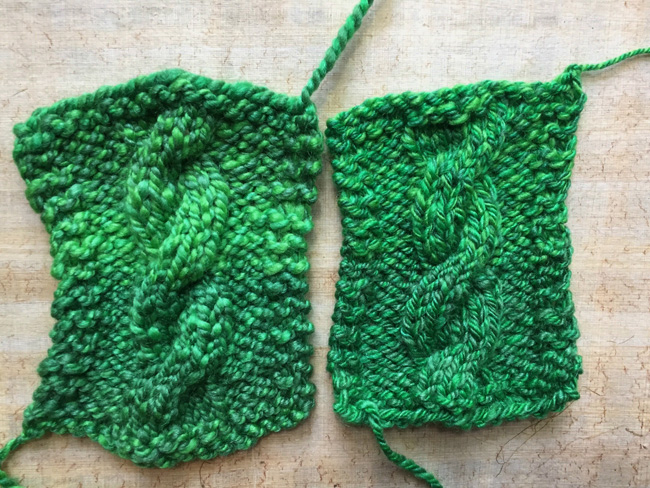
Over-plied 2-ply, and 3-ply close-up.
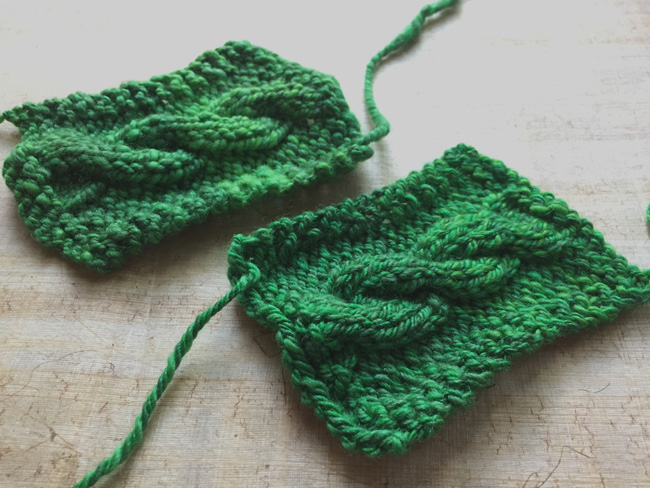
Over-plied 2-ply, and 3-ply side view.
Cables are always the test of stitch definition, aren’t they? The over-plied 2-ply doesn’t have the clean edges that the 3-ply does in a cable. It has almost as much vertical lift, and again that almost indescribable feeling of energy.
Durability
A quicky on durability.
Plying protects your precious single babies. A singles yarn is out there all on its own and gets all kind of beat up, leading to pills and breakage. When a yarn is plied, the singles protect each other by reducing the amount of surface area in each ply that is exposed. By adding extra twist, the singles are locked together tighter, further reducing that delicate surface area. Adding extra plies is even better for durability.
Weight and Yardage
Weight and yardage go hand in hand and are measured the same way, by figuring out the grist of the yarns. Grist is not evil or technical mumbo jumbo; grist can save your yarn and project. Make friends with it.
Here’s the difference in grist between the three yarns. Just a reminder: grist is measured in Yards Per Pound. All three yarns were right arounf the 12 WPI mark.
I knew the balanced 2-ply would be the lightest, and it is.
2-ply: 1,300 YPP
over-plied 2-ply: 1,075 YPP
3-ply: 950 YPP
I had thought the over-plied 2-ply would be lighter than the 3-ply and it is, not by a huge amount, but it could mean winning a game of yarn chicken. Or it means if I’m making an Aran sweater that calls for 2,000 yards, it would weigh a little more than 2 pounds in the 3-ply and 1.8 pounds in the over-plied 2-ply. I’ll take any lightening of the weight of a sweater. And if you are keeping track, the balanced 2-ply sweater would only be a pound and a half, but with drapey cables.
Color
For these samples, I used the Three Sisters colorway.

A little color left to right: balanced 2-ply, over-plied 2-ply, 3-ply.
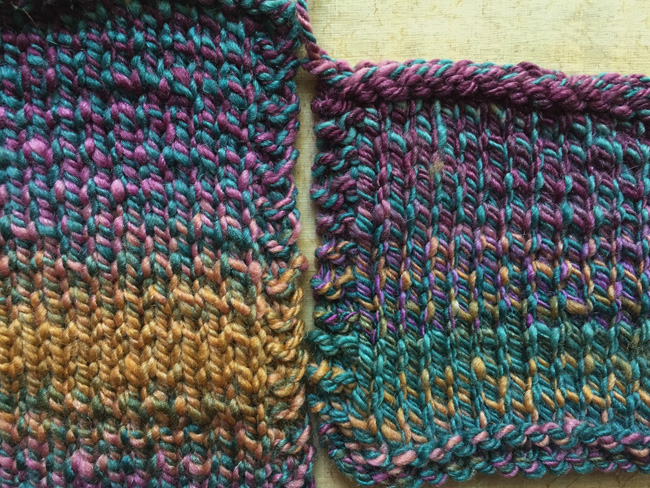
Over-plied 2-ply, and 3-ply close-up.
Color is the only spot where the over-plied 2-ply more resembles the balanced 2-ply than the 3-ply. It’s all about the size of the color runs and blending. To make my two 2-plied yarn, I stripped the fiber in half, making shorter color lengths in the colorway. Every vertical split reduces the length of each color in a colorway. Spinning and plying them marls two colors, at most, together in a medium length run of color. For a 3-ply, I split the fiber into thirds, shortening the lengths of the colors more, and in plying, I’m mixing two or three colors together.
Because of the difference in lengths of color and the number of colors marled together, the 3-ply looks spottier colorwise. Up close, you see little dots of color. But because the color dots are small, from farther away, the colors are blended together by your eyes and brain.
I find it really interesting comparing the balanced 2-ply and the over-plied 2-ply. Where the the same two colors (fuchsia and blue) are marled, the over-ply presents the two colors more distinctly, more individually, creating a spottier rather than mixed-up look
I knew I liked my over-plied 2-ply yarn, but now that I’ve done this experimenting I have a host of reasons to like it even more. I will never discount the power of twist; a balanced yarn, most certainly, isn’t the only way. The extra twist creates such excitement in knitted fabric. It's more defined yet so animated on the surface in all of the stitch patterns. I wonder if this friskiness is what I’ve always found missing in regular 3-ply yarns? I thought I was just a cheater, but this yarn does so much more than mimic a 3-ply.





 Jillian Moreno is the editor of Knittyspin. She's on the Editorial Advisory board for
Jillian Moreno is the editor of Knittyspin. She's on the Editorial Advisory board for